Tiempo Climate Cyberlibrary
Climate Change and the Himalayan Glaciers
- Tiempo archive
- Complete issues
- Selected articles
- Cartoons
- Climate treaty
- Latest news
- Secretariat
- National reports
- IPCC
About the Cyberlibrary
The Tiempo Climate Cyberlibrary was developed by Mick Kelly and Sarah Granich on behalf of the Stockholm Environment Institute and the International Institute for Environment and Development, with sponsorship from the Swedish International Development Cooperation Agency.
While every effort is made to ensure that information on this site, and on other sites that are referenced here, is accurate, no liability for loss or damage resulting from use of this information can be accepted.
 |
A global e-conference on Climate Change and the Himalayan Glaciers was held May 7-30th 2007. Tek Jung Mahat reports. |
| The author is founder/coordinator of the ClimateHimalaya initiative and is serving Environmentalists' Association of Nepal as second vice-president. | |
Glacier and ice cover some 17 per cent of the greater Himalayan region, a total area of nearly 113,000 square kilometres, the largest area covered by glaciers and permafrost outside the polar region. The Himalayan region alone has some 35,000 square kilometres of glaciers, and a total ice reserve of 3700 cubic kilometres. It is the source of the nine largest rivers in Asia, whose basins are home to over 1.3 billion people.
Various studies suggest that the warming in the Himalayas has been greater than the global average. Warming in Nepal and Tibet increased progressively within a range of 0.2-0.6 degrees Celsius per decade between 1951 and 2001, particularly during autumn and winter. The length of the growing season (daily temperature greater than 10°Celsius) has increased by almost fifteen days over the past thirty years. Glacier melt in the Himalayas is likely to increase intensity and frequency of various environmental risks, including floods and avalanches and failure of moraine dammed lakes, and affect the water regime within the next couple of decades.
A recent summary of the conclusions of Working Group II of the Intergovernmental Panel on Climate Change predicts that "if current warming rates are maintained, Himalayan glaciers could decay at very rapid rates, shrinking from the present 500,000 square kilometres to 100,000 square kilometres by 2030s".
Since the mountains and surrounding valleys are warming at an alarming rate, it is believed that the increasing temperature will also affect the biotic pool resulting to extinction of some of the precious species. Moreover, it will decrease productivity of biological systems, change floral composition, increase uncertainty, spread diseases and increase in risk of hunger and famine in some locations, finally putting human security at a high risk.
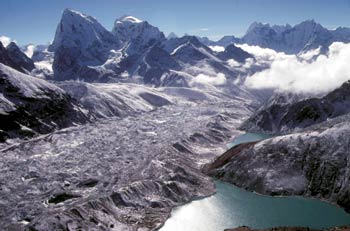 |
Ngozumpa Glacier, Nepal
© Reynolds Geo-Sciences Ltd, UK |
In this context, ClimateHimalaya, an informal and loose network of climate change professionals, promoted by the Environmentalists’ Association of Nepal, realized a need to develop a mechanism in which all regional as well as international experts working in this region can interplay to produce better information to tackle various issues related to climate change and its subsequent effect on different landscapes and at different ecological levels and finally to human security. The Climate Change and the Himalayan Glaciers e-conference held in May 2007 was the first attempt toward attaining this goal.
We received about 161 entries from around 150 participants, representing 26 countries of Africa, Asia, Europe and North America. Out of this, about 60 per cent were from Himalayan countries and the rest were from other countries of Africa, Asia, Europe and North America. The list includes many research scholars of Himalayan origin.
To keep the discussion coherent and maintain the subjective flow, the event was divided into three sessions: Current Status and Pressure; Future Potential Threats and Challenges; and Future Course of Action and Priorities. A summary of each session is given here. The complete e-conference discussion is also available.
Current Status and Pressure
Moderators: Arun B Shrestha and Samjwal R Bajracharya
Main Contributors: Adam Liddle (UK), Anil K Raut (Nepal), B K Dalit (Nepal), G Prasad Babu (India), Gehendra B Gurung (Nepal), Harshvanti Bisht (India), John M Reynolds (UK), Keshav K Sharma (Nepal), Krishna Roka (USA), Laxman Belbase (Nepal), Madan Koirala (USA), Maneesha Rajbhandari (Nepal), Narayan Chaulagain (Nepal), Narayan Dhital (Canada), Netra P Osti (Nepal), Parveen K Chhetri (Nepal), R Sreedhar (India), Rabin Sharma (Nepal), Rijan K Kayastha (Nepal), Ripendra Awal(Japan), Saima Siddiqui (Pakistan), Sudeep Devkota (Nepal), Susheel Dangol (Nepal), Tek J Mahat (Nepal), Ukesh R Bhuju (Nepal), Vibek R Maurya (Nepal), Vimal Khawas (India), Vishwambhar P Sati (India)
Gehendra Gurung urged the scientific communities to focus on immediate actions for adaptation rather than making future projections. He added that there have been considerable impacts of climate change experienced in Nepal including glacier melt and snowline retreat and the adaptation and coping measures have become urgent. Adam Liddle showed interest on snow melt and glacier retreat and the effects on land-use and livelihoods in downstream communities of North West Nepal.
R Sreedhar questioned for clarity on what is caused locally and what is contributed by the global process? He questioned the reliability of witnessing extreme weather events and microclimatic variations, which are not well recorded, to understand the trends. He further added no coping measures can be adopted without having sufficient hydro-meteorological information.
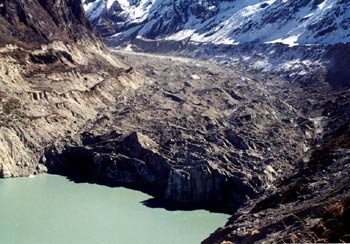 |
Thulagi Glacier tongue and the lake in the
headwater of the Marshyangdi River, central Nepal.
The lake has enlarged more than ten times in the
last 30 years
© D P Adhikari, taken October 1996 |
Vimal Khawas, referring to articles from the Times of India, etc., urged the scientific community not to overestimate the degree of glacier-related hazards. He wrote that "scientists need to be more honest about the uncertainties surrounding climate change prediction to avoid losing public trust. Once we began to exaggerate the science in either direction the debate gets out of control." He also pointed out the case of the Upper Indus Basin, where in contrary to the other parts of the Himalaya, the glacier is advancing.
Samjwal R Bajracharya, in his moderation note responding to Vimal, wrote that the number of glaciers may increase as it goes through retreat and shrinkage mechanisms, however it should not be concluded that glacier is advancing because the total area is observed to be decreasing.
Arun B Shrestha, in his moderation note responding to Sreedhar and Vimal, wrote that glacial mass balance is more negative in the Himalayas compared to other glaciated regions of the world, according to the compilation of global mass balance studies by Dyurgerov and Meier. Based on these studies, some scientist and many media suggest that the Himalayan glacier will in some decades vanish. Considering the complexity of the glacial environment and its interaction with different climatic variables, the forum has not found enough evidence to support such ideas and suggests the readers to take such suggestions with caution. Although spatially limited, there are some evidences of glacial advances. High altitude glaciers in the Karakoram have been advancing in recent decades. Due to lack of high altitude observatories, there is not much information on the climatic trends in the region and the glacial advance could be redistribution of ice-mass as a response to change in thermal regime. The Karakoram evidence does support the necessity to recognize diversity in response of Himalayan glaciers to global climate change. We need a better understanding of future climate change scenarios and its potential impacts in the Himalayan environment. Monitoring and observation has to be strengthened in the region. Local capacity building is a must. Emerging technologies have to be transferred to the region and capacity of local institutions and professionals has to be enhanced in conducting scientific studies. The next step is to prepare adaptation measures for those dangerous lakes and planned implementation of those measures. While good science can lead to good policies, sound policy formulation can foster scientific research.
Narayan Dhital presented what he saw as the major challenges: melting of glaciers, vertical shifting of vegetation and change in timing, intensity and duration of the monsoon as major climate change indicators, and adjusting the seasonal calendar of people with the changed monsoon scenario, lining up people with respect to change in monsoon pattern, gathering evidences of species (flora and fauna) responses to climate change, long-term planning to curb glacier melt and adopting low carbon practices in daily life. He proposed to live less carbon emitting life and advocated to benefit from the provisions in the Kyoto Protocol.
Madan Koirala proposed to set up monitoring mechanisms for the mountain communities, realizing the mountain specificities (mainly fragility and marginality). He proposed to internalize Indigenous and Traditional Ecological Knowledge (TEK) in modern science to perfect those monitoring systems. Bioclimatic factors may also giver better results, he added. Harshvanti Bisht informed about her project on eco-conservation and plantation of Bhojpatra (Birch) in Bhojbasa area (altitude 4100m) to investigate adjustment measures in changing scenarios of water supply, agriculture, horticulture and socioeconomic conditions and anticipated it as the biggest problem of the highlanders. Krishna Roka showed his interest and posted queries regarding past similar studies.
Tek J Mahat, referring to an article by Cameron Wake, presented glacial environment as a barometer of climate change. He wrote that the fluctuations of past and present glaciers serve as a valuable recorder of change within the climatic system. Glaciers provide a unique medium for helping unlock the secrets of our complex climate system. The glacier ice and moraine dams are relatively unstable and occasionally burst, unleashing cataclysmic floods. He reminded that the Dig Tso Glacial Lake Outburst Flood (GLOF), which occurred on 4th August 1985, resulted in debris up to 15m high down the Bhote Koshi Valley and caused loss of life and property in a large magnitude. He worried that, if the glacial retreat continues over the long term, the amount of melt water will decrease resulting to diminishing river flows and wide-spreading acute water shortages. In his next response, he informed that there have been more than 15 GLOFs in Nepal occurring at a frequency of one every two to five years, according to the Department of Hydrology and Meteorology. Lack of coordination and information sharing between researchers and institutions is leading to inadequate documentation and archiving. He warned that an outburst flood would endanger thousands of lives and cost millions of dollars in economic losses.
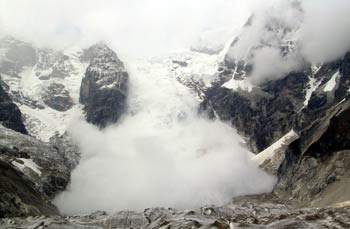 |
Avalanche at the accumulation zone of Thorthormi
Glacier, Bhutan
© T Gyalmo, Courtesy: S R Bajracharya |
Rijan B Kayastha presented his research findings in the Langtang and Lirung Khola basins, which have received considerably more discharge after 1995 as air temperature increased, although the precipitation amount did not change much. He concluded it as an implication of depletion of snow and ice in both the basins. Vishwambhar P Sati informed that the Garhwal Himalaya experienced a sudden heavy rainfall in mid-February 2007. A similar event was also experienced in 1993 when it received unexpected snowfall. He introduced findings of recent research showing glacier retreat in "Gomukh", the origin of Ganges, putting 1.2 billion people in danger, dependent to the Ganges basin. Vimal Khawas, Tek J Mahat and B K Dalit reported similar examples from India and Nepal, respectively.
Vishwambhar P Sati reported the oak forest being invaded by the pine forests (between 1000 to 1600m) in most of the areas, particularly in the south-facing slopes. This impact can be noticed in Chakrauta area (Tons valley), Pauri district (Nayar valley), Rudraprayag district (Mandakini valley), Chamoli district (Alaknanda, Nandakini and Pindar valleys). Many sources of water, such as the springs, have dried up due to disappearance of oak trees in many areas because of invasion of pine trees. He added, the impact can also be observed from the fact that musk deers have disappeared from the Nandadevi wild life sanctuary.
John M Reynolds highlighted the methodological aspects of the glacial hazard assessment in the Himalayas and Andes in order to be able to apply objective criteria rather than the emotive and subjective criteria. He urged the researchers to reassess past studies based on more scientific tools and approaches. He suggested the present discourse to be more focused on "tangible issues rather than emotive ones," in his language.
Vimal Khawas visualized the picture of an adverse bearing on interstate and intrastate disputes in Asia over water issues. He worried about possible future disputes over territories that are either the original source of water or through which major rivers flow, such as Tibet and Jammu and Kashmir. He added extreme water events (such as acute shortage and flooding) may displace a large number of people, creating a problem of environmental refuges. Climate change indeed could imperil the very survival of Bangladesh, a largely delta land that ranks as the world's most densely-populated country with the exception of island-nations and city-states. It could prompt millions of Han Chinese to move from low-lying coastal areas to the sparsely-populated regions of ethnic minorities in the southwest and west. Human security is likely to be the main casualty of climate change. Economic disparities and loss of employment opportunities in agriculture and other global warming hit sectors may worsen the situation. Given that at best it can be slowed but not stopped, climate change needs to be elevated from the current scientific- firmament discourse to a national-security issue with particular emphasis on human security. Madan agreeing. Vimal worried about Internally Displaced People (IDP) across the region.
Sudeep Devkota refers to the research by W Schlesinger at Duke University, USA, who wrote that carbon sink demand can easily outweigh the carrying capacity of nature (as tree plantation and ocean sink are referred). He proposed curbing pollution at source as the only sustainable option to control carbon dioxide emission.
Netra P Osti and Keshav Sharma gave a picture of methane and other greenhouse gas emissions from animal farms and agricultural lands. Rabin Sharma criticized the figures given by them and claimed that plants may contribute up to 40 per cent in the total methane emission. This was highly controversial. [Please note that even if the plants emit that much fraction of methane, this cannot be necessarily attributable to global warming as they have always been there in the planet. In fact, the author of the Nature paper that these figures came from had to issue a press release after his paper was mistakenly cited worldwide as blaming plants for global warming.] He wrote mass media in Nepal generally lack a sense to distinguish science from pseudoscience because they lack a science editor who has a rigorous training of scientific research and who knows what a "scientific method" is. Unfortunately, every other person in Nepal is a social activist and or an environmentalist... he added.
Future Potential Threats and Challenges
Moderators: Danda P Adhikary and Sandeep C Rai Main Contributors: Adam Liddle (UK), Arun B Shrestha (Nepal), Danda P Adhikary (Nepal), Gian L Nicolay (Ethiopia), Krishna Roka (USA), Laxman Belbase (Nepal), Narpat S Jodha (Nepal), Ngamindra Dahal (Nepal), Puneet Kumar (India), Ripendra Awal(Japan), Sandeep C Rai (Nepal), Susheel Dangol (Nepal), Tek J Mahat (Nepal)
Tek J Mahat, referring a recent article from the National Wildlife Federation, How Does Global Warming Affect Wildlife?, started a debate on climate change stress on wildlife and presented global warming as the most dangerous threat to the future of wildlife. He reported that Adelie penguins, caribou, monarch butterflies, migratory songbirds, polar bears, trout, coral reefs and arctic foxes are at verge of extinction due to global warming. He urged regional experts to focus on the impact of climate change at ecosystem, species and genetic level and requested reliable inventories. However, he criticized the extremist approach of conservation writing; it has become a "fashion" and "means of popularity" to write or speak on climate change. Some environment extremists are also trying to interpret climate change as the biggest threat to human civilization, even bigger than the terrorism. Referring to recent research, he argued that the impact of climate change could be far less than publicized. In contrary to the established fact, the evolutionary pressures of climate change will drive species development - it's already happening and we have to be prepared to benefit from this new dimension of change. He urged the scientific community to quantify the impact of climate change before making "hunch" projections and argued that synchronization of technological advancements can overcome some of the problems identified till now.
Adam Liddle recommended The Sixth Extinction by Richard Leakey, a book offering some thought-provoking reading on The Big Five and the next extinction cycle, for those interested. Puneet Kumar gave a brief introduction to biodiversity in the Indian cold deserts. He reported that many medicinal and rare plants are disappearing due to unsustainable harvesting practices and a warming planet. He shared his observation on change in precipitation patterns in Lahaul Spiti in the northern Himalayas.
Tek J Mahat, citing an article by Michael McCarthy, brought out the impact of climate change on the earth's ability to soak up greenhouse gases, which is beginning to fail because of rising temperatures, a long-feared sign of positive feedback. He added that human society has hugely benefited from the earth's natural carbon absorption facility, which means oceans and forests take up roughly half of the carbon dioxide pumped into the atmosphere. Research studies led by a team of University of East Anglia scientists shows that Southern Ocean, the earth's biggest carbon sink, accounting for about 15 per cent of the total absorption potential, has become effectively carbon dioxide-saturated. Climate change itself is weakening the saturation potential in this area. As a result, atmospheric carbon dioxide levels may rise faster and bring about rising temperatures more quickly than previously anticipated.
Sandeep C Rai, referencing NASA research in Antarctica, advanced the snow and glacier melt debate in the Himalayas to a new level. Ripendra, after analyzing the river flow data of Trishuli, argued that there may be increasing contribution of snow melt due to global warming since the analysis shows increasing runoff in the river. However, Arun clarified that there is no such indication in case of Trishuli and shared his research findings. He questioned that the analysis may be flawed and requested Ripendra to use the relevant and updated data from the Department of Hydrology and Meteorology or contact them in person.
Tek worried about the loss of aquatic flora and fauna, writing that "the flooding events will scour the species that live in the river areas," according to Lara Hansen, chief scientist at the WWF Climate Change Programme. According to her, high-altitude plants and animals that are highly dependent on the glacial melt during the non-rainy season also will be affected. As climate change intensifies, humans growing desperate for year-round water are likely to pay less attention to the needs of protecting biodiversity. Laxman Belbase linked the issue of water scarcity due to various reasons including glacier melt and change in monsoon pattern with economy of the Himalayan countries and urged to work through partnership when the issues are transboundary in nature. Gian and Narpat also highlighted the role of mutual support in dealing with this kind of issues. Gian further added that regional and global organizations like United Nations Environment Programme and International Centre for Integrated Mountain Development (ICIMOD) should play a key role to ensure sustainability of water resources in the region.
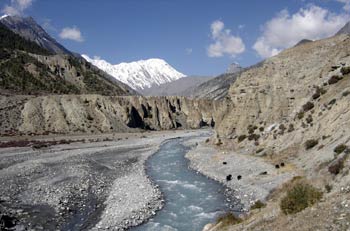 |
Marsyangdi River in Manang, Western Nepal: climate
change has added uncertainty to the perennial flow
© N Dahal |
Laxman admitted that the impact of climate change will be non-uniform in various parts of the world and developing countries are most likely to suffer. According to G H P Dharmarathne, director of the Centre for Climate Change Studies of the Department of Meteorology, Sri Lanka, the poorer countries, which were less able to adapt to the changes, would suffer the worst from the unavoidable impacts, which would be particularly severe in Africa, Asia, and Latin America. The developed countries contribute the most to global warming. He pointed out that developing countries like Sri Lanka could not afford to control or altogether stop the use of fossil fuels, "but we can explore measures to adopt and mitigate adverse effects of climate change". According to B V R Punyawardane of the of the Department of Agriculture, Sri Lanka, both the quality and the quantity of the crop would decrease due to global warming and the consequent changes in rainfall and availability of water.
According to Nihal Abeysinghe, there is a clear link between the local climate and the occurrence or the severity of some diseases. Certain serious diseases appear only in warm areas and also higher temperatures can increase air and water pollution. Since these effects are unavoidable, adaptation is the only solution. Ngamindra Dahal advocated to look the climate change-induced issues in a wider level. He highlighted changes in temperature, wind and precipitation, weather hazards, vegetation, water supply and housing, agriculture and lifestyle/ business as major areas to be considered for climate change research. He gave a brief account of climate change impacts in the Annapurna Conservation Area Project (ACAP) region of Nepal, witnessing impacts of climate change making local communities' hardships further worse. Tek proposed to consider community and social vulnerability for climate-related researches. Krishna joined the issue with couple of examples.
Laxman Belbase highlighted the petition filed by Pro Public before the UNESCO World Heritage Committee (WHC) and informed that there is little effort from Nepal’s side to place Sagarmatha National Park in the list of vulnerable World Heritage Sites. He added that WHC has paid more attention and assured to discuss the agenda at their general assembly. He urged for a global commitment the sustainability of those precious resources.
Danda P Adhikary and Sandeep C Rai, in their moderation note, wrote that biodiversity loss and species extension could easily outweigh the emergence of new species. That’s why we need to worry about vertical shifting of some species as they respond to global warming. They argued that scientific communities should not generalize serious issues like biodiversity loss with respect to rare examples. A small number of new species cannot complement a large number that are at risk of extinction. They also worried about coastal countries, mainly as a result of glacier melting, as the sea level rises there will be a big problem. Sandeep claimed that water scarcity will be biggest problem in the near future outweighing national economy in many parts of the world. Sandeep emphasized the need to focus on post-2012 negotiations related to the Clean Development Mechanism to attain a significant cutoff in greenhouse gas emissions.
Narpat S Jodha stated that the global warming debate has created more noise and scare rather than positive pathways. He said the situation in terms of solid data and models is much better today, but the regional context of the future changes continues to be uncertain. Adaptation to warming is yet another big issue. By accepting this, we seriously undermine the human potential to adapt to the change. Gian, agreeing with Narpat, urged for local-level initiatives, including capacity development at the community-level, to tackle future problems. Both Narpat and Gian agreed that at least the positive development of climate change campaign has increased awareness at different levels and that can be very useful when developing adaptation plans.
Future Course of Action and Priorities
Moderators: Madan Koirala and Ngamindra Dahal
Main Contributors: Basanta Shrestha (Nepal), Bhubaneswor Dhakal (Nepal), Birendra Bajracharya (Nepal), Chu Duo (TAR), Deoraj Gurung (Bhutan), G Philip (India), Gian L Nicolay (Ethiopia), Hammid Ch. (Pakistan), John M Reynolds (UK), Laxman Belbase (Nepal), M P Shah (India), Megh R Dhital (Nepal), Narpat S Jodha (Nepal), Ngamindra Dahal (Nepal), Parveen Chhetri (Nepal), Pradeep K Mool (Nepal), R Sreedhar (India), Rabin Sharma (Nepal), Rajiv M Bhagat (India), Rakhshan Roohi (Pakistan), Samjwal R Bajracharya (Nepal), Sharad P Joshi (Nepal), Tao Che (China), Tek J Mahat (Nepal), Ukesh R Bhuju (Nepal), Vaibhav Kaila (India), Vimal Khawas (India)
Bhubaneswor Dhakal discussed climate change prediction methods and the vulnerability of mountain people, especially in the Himalayan context. Parveen, responding him, highlighted the salient features of dendrochronology and presented it as a most scientific way for climate change study. Tek floated the issue of the vulnerability of indigenous people around the world due to climate change, citing John Scott from the Secretariat of the Convention on Biological Diversity. John M Reynolds, along with reference to his review article published in Mountain Research and Development in 2004, attempted to draw clarification on glacier inventory and hazard mapping in the region. Samjwal and Pradeep mentioned various aspects of glacier and glacial lake inventory in the region, clarifying for John ICIMOD’s inventory published in 2001. Sharad highlighted other aspects of the inventory report. Basanta and Birendra discussed the lack of remote sensing images and other challenges during development of those inventory reports. John emphasized the use of globally-accepted standards.
Chu Duo, Deoraj Gurung, G Philip, Hammid Ch., Megh R Dhital, Rajiv M Bhagat, Rabin Sharma, Rakhshan Roohi, Tao Che and Vaibhav Kaila joined the discussion on the glacier inventory. They appreciated the inventory work carried out by ICIMOD, despite limited sources of information, and referred to it as a milestone in the area of glacier studies in the region. They also thanked the ICIMOD GLOF team for providing their technical assistance to carry out similar studies in India, China, Pakistan and Bhutan. However, regional experts were criticized for complementing peer-reviewed journal articles by publishing books only. Rabin Sharma urged the regional experts to present their research works through the journals that have wider access, scrutiny and validity. All the commentators urged the inventory team to update their report published in 2001.
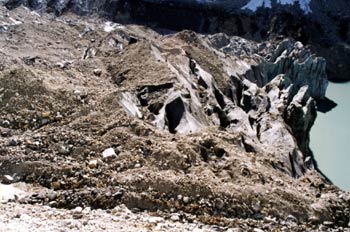 |
Development of deep crevasses in the glacier front
as a process of glacier retreat in the Thulagi
Glacier, headwater area of the Marshyangdi River,
in central Nepal
© D P Adhikari, taken October 1996 |
R Sreedhar raised the issue of whether there were more dependable ways of predicting weather patterns in every cropping season and also raised queries regarding extreme events, especially cloud-bursts and hailstorms. Ngamindra, responding to Sreedhar, expressed the view that the perceptions of scientists and development practitioners in the field of agriculture, forestry and water would help streamline the discussions. Tek joined the conversation with a clipping from German environment minister Sigmar Gabriel, who has said that about 150 species disappear every day.
Sunita Narain's editorial No more Kindergarten Approach to Climate, published in Down to Earth, forwarded by Tek, drew the attention of the participants. Vimal was of the opinion that the human dimension has been inadequately looked into in the context of the debate on climate change. Narpat joined Vimal's view with adaptation practices done by humans in context to livelihood strategies such as planting trees, which in turn has contributed positively to climate change. An article by Ngamindra entitled "Implications of Climate Change on Biodiversity in Nepal: Some Observations and Opportunities" contributed to the debate at an interface.
Finally, Tek, providing sufficient evidences of adaptation measures to tackle climate change, urged the global community to work through partnership. He proposed the "National Environmental Happiness Index" for better assessment of the environment of a country and to allocate available resources equitably for wise and sustainable planning.
Conclusions and Resolutions
- Debate on global warming (glacier melting included) has revealed diverse views and perspectives. This debate helps the process of reaching better truth and should be encouraged.
- A higher priority should be given to focused work with scientific objectivity in diverse situations.
- Adaptation-focused research addressed to specific contexts should also be given high priority.
- The present e-conference has demonstrated its utility and need as well as imparting considerable confidence to the organizers to repeat the email-based debate on other related subjects.
From concluding remarks by Narpat Singh Jodha, ICIMOD
Acknowledgements
This report was prepared in consultation with session moderators and with support from Laxman Belbase and Parveen Chhetri. The e-conference was organized by the Environmentalists' Association of Nepal in association with the Ministry of Environment, Science and Technology, Government of Nepal. The organizers thank the International Center for Integrated Mountain Development, IUCN Nepal, National Trust for Nature Conservation, Tribhuvan University, WWF Nepal and Pro-Public.
Further information
ClimateHimalaya, c/o Environmentalists’ Association of Nepal, Kathmandu, Nepal. Email: climatehimalaya@gmail.com. Web: www.freewebs.com/climatehimalaya.
On the Web
The Tiempo Climate Cyberlibrary maintains a listing of key websites covering mountains and climate change.
Bright Ideas

General Electric plans to cut solar installation costs by half

Project 90 by 2030 supports South African school children and managers reduce their carbon footprint through its Club programme

Bath & North East Somerset Council in the United Kingdom has installed smart LED carriageway lighting that automatically adjusts to light and traffic levels

The United States National Oceanic and Atmospheric Administration and the American Public Gardens Association are mounting an educational exhibit at Longwood Gardens showing the link between temperature and planting zones

The energy-efficient Crowne Plaza Copenhagen Towers hotel is powered by renewable and sustainable sources, including integrated solar photovoltaics and guest-powered bicycles
El Hierro, one of the Canary Islands, plans to generate 80 per cent of its energy from renewable sources

The green roof on the Remarkables Primary School in New Zealand reduces stormwater runoff, provides insulation and doubles as an outdoor classroom

The Weather Info for All project aims to roll out up to five thousand automatic weather observation stations throughout Africa

SolSource turns its own waste heat into electricity or stores it in thermal fabrics, harnessing the sun's energy for cooking and electricity for low-income families

The Wave House uses vegetation for its architectural and environmental qualities, and especially in terms of thermal insulation

The Mbale compost-processing plant in Uganda produces cheaper fertilizer and reduces greenhouse gas emissions

At Casa Grande, Frito-Lay has reduced energy consumption by nearly a fifth since 2006 by, amongst other things, installing a heat recovery system to preheat cooking oil
Updated: May 15th 2015